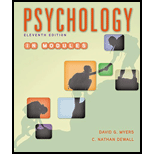
Introduction: Measures of central tendency contribute to summarizing data. These involve the mode, the median, and the mean that represent the middle of the data distribution. The mode is the value that occurs most commonly in distribution, the median is the middle value, and mean is the average value of the observations.
Answer to Problem 19TYS
Correct answer: The mean is the measure of central tendency that is most easily distorted by few very large or very small scores. Therefore, option b. is correct.
Explanation of Solution
Reason for the correct statement:
The mean value is obtained by summing the scores and dividing it with the number of scores. It involves every score in the distribution; thus, any change in the score value would alter the value of mean. If the distribution contains some extreme scores (such as very small or very large values), the mean would be easily displaced. In this case, the mean would not provide the central value.
Hence,option b. is correct.
Reasons for the incorrect statement:
Option a. is given as “the mode”. The mode is the most commonly occurring score in the distribution. Hence, it is a wrong answer.
Option c. is given as “the median”. It is the middle value when data is distributed in ascending or descending order. It requires scores from smallest largest values. Hence, it is a wrong answer.
Option d. is given as “they are all equally vulnerable to distortion from atypical scores”. All three measures of central tendency are equally distributed if there is symmetrical distribution. The mean denotes the average value, so it is most commonly distorted with extreme variations in the scores. Hence, option d. is incorrect.
Hence, options a., c., and d. are incorrect.
Want to see more full solutions like this?
Chapter 4 Solutions
Psychology in Modules
- Can you create 3 facilitation session plans in which a school counselor facilitates a play experience with a group of children? The 3 plans should include a target group, the play media used, the 3 session titles, a description of the American School Counselor Association (ASCA) domains, the ASCA mindsets and behaviors, the purpose, session objectives, the materials, step-by-step directions for the entire session (beginning, middle, and end), and be specific and detailed enough for another school counselor to easily facilitate each part based on the information provided in the plan. Please write in narrative format and include citations and references with the appropriate website link.arrow_forwardHI Hi with this unit/ assessment PSY4406 TP4 Report assessment material case stydu Ms Alecia Moore. on google search bar it appeared the whole report was already written, including the answers, how can obtain the full version that was on preview on the google search, as i would like to use this as template to similar case study i have in my workplace report writting for future clients. As first year graduate student im looking for support in writting psychological reports. and this example layout draw my attention. your response is greatly appricatedarrow_forwardCreate a post of 150 words reflecting on the items below. Instructions: Begin by reflecting on your own experiences with music technology, including how you discover new music, your preferred listening platforms, and any notable changes in your music consumption habits over time. Discuss the impact of streaming services like Spotify, Apple Music, and YouTube on music accessibility and the way artists distribute and monetize their work. Explore the role of algorithms and personalized recommendations in shaping music discovery. How do these algorithms impact the diversity of music we encounter, and are there potential drawbacks to algorithm-driven content curation? Consider the benefits and challenges of digital music production tools for artists. How has technology democratized music creation, and what new possibilities does it offer for artistic expression?arrow_forward
- Hi with this unit/ assessment PSY4406 TP4 Report assessment material case stydu Ms Alecia Moore. in the Assessment tool 2 - Trait emotional intelliegence can you provied the results for the test, and the test results for Assessment 3 - Mini International personality item pool. https://www.bartleby.com/docs/psychology/4369920 thanl you, your response is greatly appricatedarrow_forwardWhat are the expectations going into the internship with high school student beahavoir?arrow_forwardWrite a 1,200-1,500-word analysis that describes the characteristics and roles you hope to embody as a counselor and the counselor dispositions that you want to bring with you. You may write in the first person for this assignment. Include the following in your analysis: Your role as a clinical mental health counselor or school counselor in the agency, school, and/or community you serve. Include strategies for collaborating and consulting with behavioral health care professionals. Refer to the importance of certification and licensure related to your role and professional identity. Strategies to develop a counselor identity that fosters leadership, advocacy and provides services as a licensed professional counselor or school counselor for persons with mental health issues. Depending on your program of study, refer to the GCU "SC Professional Dispositions of Learners" or the GCU "Counselor Dispositions" located in the Class Resources when completing this assignment. Consider your…arrow_forward
- what makes yoruba different from other religions or culturesarrow_forwardWhat does the PIC/NIC Analysis focus on from the Performer's Perspective? Consequences Antecedents Behavior X Behavior Yarrow_forwardWhat does the PIC/NIC Analysis focus on from the Performer's Perspective? Consequences Antecedents Behavior X Behavior Yarrow_forward
- The Performance Diagnostic Checklist-Human Services (PDC-HS) is an assessment tool to identify areas of improvement for employee performance within a work environment. For this task, you can complete the PDC-HS as a self-assessment within your work requirements or you can interview a colleague. Describe the performance concernarrow_forwardWhat are three methods for dissemination of information that school counselors can use after watching the YouTube video titled: “Self-care for school counselors” (https://www.youtube.com/watch?v=hvQyjEh1Lmk) by CSCA Executive Director (2020, April 2)? Please write in a narrative format and include citations and references.arrow_forwardWhat are the three most relevant principles school counselors need to be aware of watching the YouTube video titled: “Self-care for school counselors” (https://www.youtube.com/watch?v=hvQyjEh1Lmk) by CSCA Executive Director (2020, April 2))? Please write in a narrative format and include citations and references.arrow_forward
 Ciccarelli: Psychology_5 (5th Edition)PsychologyISBN:9780134477961Author:Saundra K. Ciccarelli, J. Noland WhitePublisher:PEARSON
Ciccarelli: Psychology_5 (5th Edition)PsychologyISBN:9780134477961Author:Saundra K. Ciccarelli, J. Noland WhitePublisher:PEARSON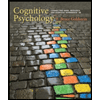 Cognitive PsychologyPsychologyISBN:9781337408271Author:Goldstein, E. Bruce.Publisher:Cengage Learning,
Cognitive PsychologyPsychologyISBN:9781337408271Author:Goldstein, E. Bruce.Publisher:Cengage Learning,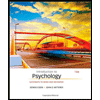 Introduction to Psychology: Gateways to Mind and ...PsychologyISBN:9781337565691Author:Dennis Coon, John O. Mitterer, Tanya S. MartiniPublisher:Cengage Learning
Introduction to Psychology: Gateways to Mind and ...PsychologyISBN:9781337565691Author:Dennis Coon, John O. Mitterer, Tanya S. MartiniPublisher:Cengage Learning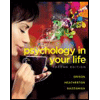 Psychology in Your Life (Second Edition)PsychologyISBN:9780393265156Author:Sarah Grison, Michael GazzanigaPublisher:W. W. Norton & Company
Psychology in Your Life (Second Edition)PsychologyISBN:9780393265156Author:Sarah Grison, Michael GazzanigaPublisher:W. W. Norton & Company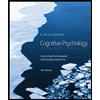 Cognitive Psychology: Connecting Mind, Research a...PsychologyISBN:9781285763880Author:E. Bruce GoldsteinPublisher:Cengage Learning
Cognitive Psychology: Connecting Mind, Research a...PsychologyISBN:9781285763880Author:E. Bruce GoldsteinPublisher:Cengage Learning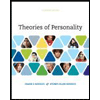 Theories of Personality (MindTap Course List)PsychologyISBN:9781305652958Author:Duane P. Schultz, Sydney Ellen SchultzPublisher:Cengage Learning
Theories of Personality (MindTap Course List)PsychologyISBN:9781305652958Author:Duane P. Schultz, Sydney Ellen SchultzPublisher:Cengage Learning





